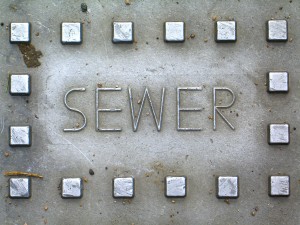Dealing With Sewer Problems
Just thought I would throw this out so it doesn’t come as a surprise to you, but simply put, sewer problems are crappy!
I’m probably not alone in thinking this, but if any of you reading this own properties that were built in the 50’s, 60’ or even potentially the 70’s in some areas you need to know about this before you find out the hard way. You see I’m going through some unexpected sewer problems and it looks like I could be out of pocket to the tune of $5,000.
The problem comes down to the type of pipe that was used to build many of the sewer systems in areas like Forest Lawn here in Calgary. Through much of the 1950’s, 60’s and some of the 70’s, all the rage was to use what was referred to as a no corrode pipe for sewer lines. You can tell by its name what the big benefit was, it didn’t corrode.
Unfortunately, it also only has a life expectancy of usually a maximum of 50 years. In most cases, it’s actually much shorter.
In some of my research, it appears these pipes were made with tar paper or tar pitch and ground cellulose (wood) and go back as far as the 1800’s. Over time depending on how they were constructed the tar paper linings tend to wear out and separate internally or the pipe itself starts to collapse. In my case, I have both of these happening along with a complete break.
Options For Dealing With Sewer Problems
Now there are methods to repair minor sewer problems without having to dig everything up. The first one I looked into after a referral from my plumber was a method of inserting an epoxy splint into the sewer pipe. This splint then gets expanded out like a balloon to form a new inner lining. In the case of a pipe that is starting to decay internally, this works phenomenally. However, for a collapsing pipe, it doesn’t work as well, unless it is just a minor collapse.
Option number two that I am at involves trenching part of the line then pulling the old pipe out and pushing through a similar type of sleeve. This one I haven’t figured out exactly how it works yet, but will likely be the method I have to run with as I also have a tree in the way.
Option three is a full and complete trench through my yard, digging up some sidewalk, removing a fence and potentially a tree. This is my most happy solution of crappy options. It might be a bit cheaper, but involve many other headaches.
So what are your options if you have a similar type of property? Well you can do a few things. If you are unsure of what type of piping you may have, you can try calling the city and see if they can update you on what type of piping was used in your neighbourhood. This is the most cost effective way as it’s free, but they may not be able to tell you.
Alternatively, you can hire a plumber or sewer service that has a camera that can be used to inspect your sewers. This can run from $300 to $600 depending on who you use, but can give you a clear picture (pun intended) of what you have in place.
If you find out you do have the no corrode pipe, it is just a matter of time before you have issues, so either start saving up and preparing for the expense or consider bringing someone in to fix the issue before it gets worse.
As a side note, if you ever have a sewer blockage in your home or rental property you can call the city in most areas who will come as soon as possible to clear the blockage. (This is whee the 311 numbers come in handy!) They won’t fix the issue, but they will come clear the blockage. After it’s done you may still need to bring in a plumber later to fully repair or inspect, but this can buy you time. In my case, the city came initially and cleared the blockage and then even arranged to come back a few weeks later with their camera to inspect the pipe.
That’s when I found out about no corrode pipe. They also misdiagnosed the actual pipe separation and collapse and only saw the inner liner coming apart, but nobody’s perfect.
Forest Lawn and the surrounding districts have been highly recommended by REIN over the years as a great investment area and it truly is as it has plenty of renters, is close to downtown and has a huge upside. Just take into consideration the potential for issues underground.
Investor Perspective
These are the types of issues you cannot really budget for, but should fit under your reserve fund category as emergency repairs. In a normal situation holding a $5,000 reserve would cover something like this, but then leave you short for the next few years as you build it back up.
I’ve already looked a bit into whether our insurance covers it and unfortunately it does not. Also the city is only responsible up to the property line, so in the end it all falls back to the property owner.
If you are buying in one of the areas susceptible to problems like this it may be important to pay for an additional sewer inspection so you know what you are facing and to ensure the current owner is questioned about any previous sewer issues. Then at least you can pre-budget or use it as a negotiating tool.



This is bad news as my properties are the same age. Insurance doesn’t cover this?
I guess I need to build up some reserve funds.
Unfortunately unless you have specific riders for something like this the insurance you pay to protect you for the unexpected, expectantly doesn’t cover it. It also explains why the streets are so torn up in the area as it seems every week they have to fix another sewer problem in the area.
Bill
I remember in my natal town (Rosario, Argentina) they are actually replacing all downtown water lines in downtown , but instead of digging the sidewaks away, they replace an entire block pipe at once, using a device called “The neumatic Mole with fracture head” and is basically a device with a cone point that hammers like a 1 inch/second at a time through any pipe and opens a path so a new pipe can be inserted in the new hole (the old pipe, 80-90 years old broken clay in this case, stays in place, but is like it’s “open” like a flower from the inside. I understand you can’t backup the thing back though the same hole it came from, though, but you are supposed to have a destination hole already digged. Or even better, it can dig an entire new hole paralell to the existing one (or use the same one with the right head). May be worth to investigate if something like this exists around here.
http://www.ttc.latech.edu/publications/guidelines_pb_im_pr/moling.pdf
Thanks for the info Daniel. It almost sounds like they do a variation of this, but truth be told I kind of glazed over a bit once I heard the price. They pull the old tube back from the opening the city will make on the street side and push this new tubing out right behind it. I don’t know if they use a pneumatic mole, leverage or tricks of the trade though.
Regards,
Bill